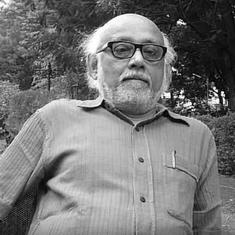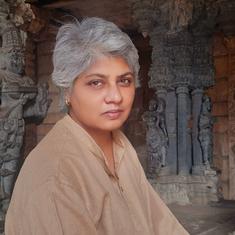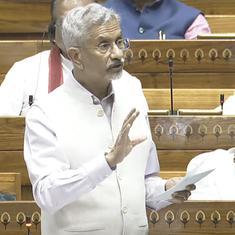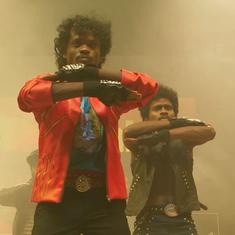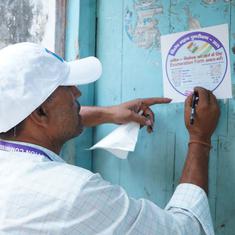Illustrator Anand Radhakrishnan is the first Indian to have won a Will Eisner award, known as the Oscars of comic books. His award came in the Best Painter / Multimedia Artist (interior art) category for his drawings for the Ram V’s graphic novel Blue In Green. Colourist John Pearson was also named for the award. Radhakrishnan spoke to Scroll.in about his work and life. Excerpts from the interview:
How does it feel to have won the Eisner?
So the thing is, we were nominated a couple of weeks before the award was announced, so we already knew we were going to be in the race, and I wasn’t completely shocked. It was still really nice to have actually won it.
Could you tell us a little more about the category in which you won the award?
It’s for Best Painter / Multimedia Artist. It’s one of those categories that is still fairly new. Conventionally, it’s best penciller, best inker, and best colourist. In the 1980s and 1990s, when painted comics were supposed to be a big thing, they started this particular category. Ours involved various different mediums, like pencil, acrylic, and then John Pearson went on and coloured it digitally, so I think that’s why they considered our work for this category.

In an earlier interview with Astray, you mentioned that you try to do something different with every project you work on, and you don’t like to repeat yourself. Could you tell us more about the way your personal voice responds to the story that you’re presented with?
The thing is that I went to JJ Institute for Applied Arts in Mumbai when I was doing my undergraduate studies, and that course centred around advertising. I think my brain kind of started thinking in that direction, since with illustration within the advertising community, you are expected to adapt. I found that was my calling: I was pretty good at adapting to different tones, and that’s where I became interested in storytelling as well.
I do think I have a way of drawing: I draw a certain way in my sketchbook, and I think I can call that my style. But then the thing is that I’m kind of selfish too – I like to draw different things. One day, I’d like to draw horror, the next day I would draw something that’s a little more lighthearted. One style won’t be able to carry the nuances that are required for two different genres. I want to be able to work in different genres, which is why I never tied myself down on one way of drawing.
That’s why, when I begin working on a project, I spend some time researching it, working out the tone is. I feel the tone is really important when it comes to narrative projects. Graffitiy’s Wall was based on four teenagers in Bombay, trying to chase their dreams – it was a slice of life story, it was lighthearted, and had jokes in it. Even the characters were a little bit on the nose, everything was exaggerated, colourful – so the style is like caricature, simplistic, and at the same time it’s fun.
But Blue in Green is the opposite of that: it’s about existentialism, depression, it’s about the pursuit of excellence and what you have to give up for that, you know. It’s about a lot of loss, so obviously the style couldn’t be lighthearted. We spent some time figuring out what the style should be for this book, and Ram Venkatesan and I did this very intimately.

You’re from Mumbai, and Grafitty’s Wall, and some of your illustrative projects, are rooted in the city. This is a context you are familiar with. But Blue in Green is situated outside India and is incredibly detailed. How did you work with this context?
So Ram spent a few years, when he was studying engineering, in the US. He was quite familiar with the jazz scene there, but I personally have nothing to do with jazz. I followed music for a while, when I was in college, but it didn’t work out.
Jazz wasn’t really something that really appealed to me, but what did appeal to me was the character’s journey, the inner turmoil there, a certain idea of struggling to achieve greatness. Even though it’s based in the US, some of the themes are very universal, the whole struggle thing, the art thing, pursuing excellence and loss of life. In the arts, there’s a romanticised idea of the artist struggling to achieve something, and that the journey makes the art deserve greatness. This was something I was thinking about a lot and that appealed to me more than the setting of it.
Even though it is based in the US, I didn’t spend a lot of time doing research. I put on some jazz while working just to get into it, but wasn’t blaring it the whole day. I used to listen to my audiobooks while working, which had nothing to do with America or jazz. I also didn’t have to go into it that much. The script would be fairly detailed. Ram would mention that so-and-so happens on this page and there’s a club that looks like this, the owner has this kind of face, so you know he’d be giving me visual cues. While there’s a lot more I added, the script is quite detailed.
The way we collaborated on Blue in Green was very organic, towards the second half especially. For twenty to thirty percent of the tailend, I would do a page and then send it to him, and then he would tell me what happens on the next page, which is not a conventional way of going about comics.
Ideally, he would have written the whole script and I would draw it, but we thought this would fit the book more because it didn’t have a conventional plot and the character just goes through the motions. We thought it would be nicer if we kept it organic and figured out what happens on the next page depending on what happens in the previous page. It also makes you feel jazz is being played.
Yes, because of the improv.
Yes, improv, that’s the word.

When I was going through Blue in Green, I noticed that several drawings seemed to lack concise, sharp edges. In some ways, there’s uncertainty and a lack of focus in form. It’s always a bit blurred. Why did you choose to use this style?
I definitely did it intentionally, but I’m not exactly sure if there’s a concrete reason. It gives the audience a little bit of an abstract feel when they look at it. There are also elements in the book which make the readers wonder if these things really exist in the story or if they are figments of the characters’ imagination, or metaphors in the book. I was trying to play with these ideas and not tell the audience which is which. We don’t define what is real and what is not in the book anyway, and I didn’t want to use style to make it clear. Some of those lost edges and blurry edges…that’s why I must have done it.
There are also two distinctly different styles I used. One is more graphite plus ink plus digital colour, for the present. There are two timelines, and the one in the past is acrylic and digital colour.
Does your process change depending on the project you’re working on, or do you have a very specific process?
The bare bones of it remain the same. I do small rough drawings first on the page: really roughly, quickly drawn panels and shapes to see what is going on. From there, we go to research and pencils and referencing, inking, whatever the medium is. Then from pencils, to inks, to colours. For different projects, I do adapt to a different style.
My current project, titled Radio Apocalypse, is more in ink. I’m working on it with Ram and it’s about a particular radio station that has survived the apocalypse. So society has gone to shit and all that, but this radio station stands. The book looks at why it stands, and the people it’s centred around.
For this, I had a completely different approach because it is line art, but the style remains realistic and is also exaggerated. I wanted to do 1980s-1990s nostalgia meets street-wear, pop. Blue In Green stuck to realism quite a bit so that when there are scenes that are unreal, the realistic provides a stark contrast.
I adapt with each project I do, I try to change my style according to the tone of the book, and when I change my tone, my process automatically changes with that.

Could you tell us about the research that goes into your work?
I honestly don’t research too much because I think it tends to take away from it. Most times, I let the reader read into it and try not to preach. When I over-research something, my understanding of the subject seeps into it and I try not to do that. Of course, when the story requires it, then yes for sure.
There are subtexts to Grafitty’s Wall, right, like Mumbai and slum-rehabilitation and corporations and capitalism. In the end, I am the artist of the book. Even though I do try to leave easter eggs here and there, I don’t want to preach to the audience. Also, most books are on tight deadlines, I don’t get the time to research everything.
In Radio Apocalypse, the civilisation we’re talking about in the first issue has been established after the event that caused the apocalypse. The whole city and area are shanty towns, so I looked at how shanty towns happen, how they are set up, which helped me design the settlements. The research helps me design it, instead of letting me talk about it. As a rule, I don’t like media that preaches to me.
Is keeping an art journal a habit you’ve developed over time? What goes into these journals?
I’m a huge advocate for my sketchbook and I suggest it to everyone who is starting out: students, everyone. Sketchbooks let you play around with things you wouldn’t get to professionally. When you say journal, I think of it as my sketchbook, because it’s my visual journal, I carry it around.
I do all kinds of things in it: I put down my ideas visually or I write them down. I put down story ideas, when I’m in a restaurant and getting bored, I draw. It’s just everything.
I think of my sketchbook as the centre of my practice, so that helps me dig an anchor into the ground. It makes it easier to come back to that anchor, wherever I go.
Another thing that doesn’t get noticed enough is that a sketchbook is the place where you are allowed to do bad work. Professionally, you don’t have that. There’s no other place where you’re allowed that slack where you can do ugly work. My sketchbook is where no one is allowed to look at my sketches, unless I give them express permission. No one judges me, I can do whatever the hell I want, and I can create whatever ugly stuff I want to.
Coincidentally, what happens when I do stream-of-consciousness drawings, most times, is that it snowballs into a larger project. There have been a couple of projects that happened that way.

For several artists, it’s hard to negotiate a relationship with social media. Have you encountered this sort of tension? Do you have any advice?
I started drawing professionally when Facebook was about to get very popular, around 2012 and 2013. It reached its peak and then it was downhill for Facebook. Instagram wasn’t around at that time. I remember feeling the pressure to post on Facebook, and I would post something and go to sleep so I’m not looking at it.
In the morning, I would see, “Oh my god, there’s so many likes”. It used to be exhilarating and still is, so I’m not going to deny that I’m in the race as well. If someone shares my work, or shouts out, the number of my followers increases. These are all traps I’ve definitely fallen into.
One good thing I’ve managed to do is I don’t depend on Instagram for a living. It’s not a bad thing of course: anything that provides people with an income is great. But my main work that provides me with a living doesn’t depend on Instagram at all. I’ve made very little money, or none, from Instagram. I work in comics and it’s a very offline thing, so even if I got off Instagram, I won’t really suffer.
But for sure, the validation does help: it makes you feel good, more than anything else. And I do think that this pressure to put things out can be taken positively. I have these bouts of feeling low a lot, so sometimes when you have that social pressure of “Arre, kuch banaya nahi, bahut din se, dalna padega,” it kind of does push you. Although that’s not healthy for sure, there are many things that are not healthy but that do help you in some way or the other. I don’t really mind it.
I’m not someone who thinks that technology is inherently a bad thing. I think it depends on how you use it. It’s what they say, right, “The dose makes the poison”. So it depends on how much you use it – sometimes I’m addicted to it and stuck to one place looking at it for hours.
But it does help me in many ways: it helps me keep in touch with my peers and contemporaries. I also treat it like a portfolio. I’m a very private person so I don’t post a lot of my personal stuff online, pictures of my family, etc. I try to treat my Instagram very professionally.
I tend to post work-in-progress and sketchbook stuff on it, which isn’t anywhere online. My finished drawings go into comics after colouring, so the black-and-white stuff that I do on my drawing board doesn’t really get an out to the world, so social media is a good way to put that out. To give glimpses of the behind-the-scenes to the audience.
My random drawings and explorations that aren’t going into projects also get a way to go out. I also do archive stuff, and put images of other artists and things I like or want to try into a folder. If I see a technique someone must have tried, I think, “Maybe I should try that!”

Do you have a favourite comic book?
To be honest, I get embarrassed everytime I answer this. There was this time in college, second or third year, when I used to be into comics quite a bit. Around the same time I met my wife, and she introduced me to manga and comics. It kind of changed my whole direction.
Now, I read the comics of my peers and complimentary comics I’m sent, or while making covers. So I do read for work, but I don’t really read comics for leisure. I read a lot of prose, which is a little bit weird because I work in the field but I don’t really consume it.
There’s a prose book I just returned to, called The Corrections by Jonathan Franzen. That’s one of my favourites. I love the classics too, but I keep returning to this book, about a dysfunctional family. The characters are very nuanced and it’s very interesting.
What’s your go to anime?
My favorite is Akira, and one by Satoshi Kon that I really enjoy – Paranoia Agent. It’s about a bunch of people falling victim to one kid, but they don’t know if that kid exists or not, because all the people who fell victim had something to avoid. So they’re relieved from that situation when they’re attacked. It happens in the city many times, so no one knows if that attacker is legit or not.


